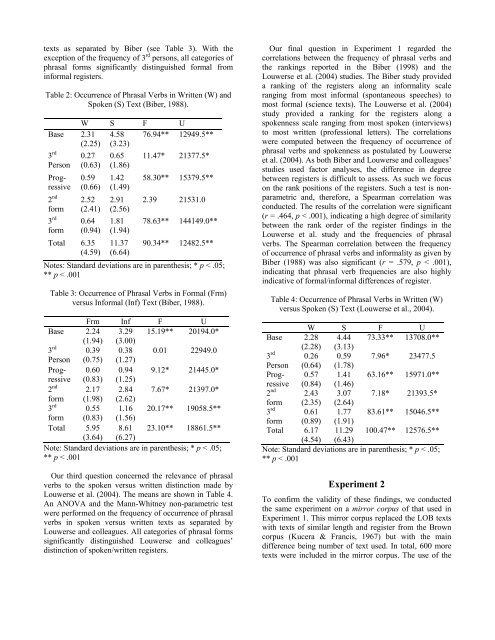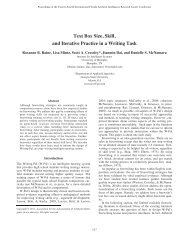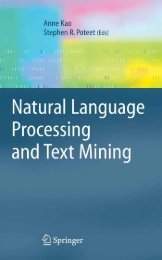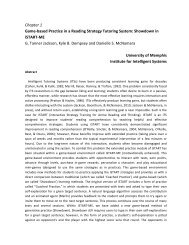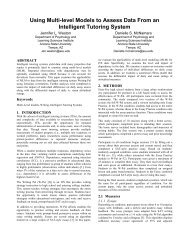Identifying Text Genres Using Phrasal Verbs
Identifying Text Genres Using Phrasal Verbs
Identifying Text Genres Using Phrasal Verbs
You also want an ePaper? Increase the reach of your titles
YUMPU automatically turns print PDFs into web optimized ePapers that Google loves.
texts as separated by Biber (see Table 3). With the<br />
exception of the frequency of 3 rd persons, all categories of<br />
phrasal forms significantly distinguished formal from<br />
informal registers.<br />
Table 2: Occurrence of <strong>Phrasal</strong> <strong>Verbs</strong> in Written (W) and<br />
Spoken (S) <strong>Text</strong> (Biber, 1988).<br />
W S F U<br />
Base 2.31 4.58 76.94** 12949.5**<br />
(2.25) (3.23)<br />
0.27<br />
(0.63)<br />
0.59<br />
(0.66)<br />
2.52<br />
(2.41)<br />
0.64<br />
(0.94)<br />
Total 6.35<br />
(4.59)<br />
0.65<br />
(1.86)<br />
1.42<br />
(1.49)<br />
2.91<br />
(2.56)<br />
1.81<br />
(1.94)<br />
11.37<br />
(6.64)<br />
11.47* 21377.5*<br />
58.30** 15379.5**<br />
2.39 21531.0<br />
78.63** 144149.0**<br />
90.34** 12482.5**<br />
Notes: Standard deviations are in parenthesis; * p < .05;<br />
** p < .001<br />
Table 3: Occurrence of <strong>Phrasal</strong> <strong>Verbs</strong> in Formal (Frm)<br />
versus Informal (Inf) <strong>Text</strong> (Biber, 1988).<br />
3 rd<br />
Person<br />
Progressive<br />
2 nd<br />
form<br />
3 rd<br />
form<br />
Frm Inf F U<br />
Base 2.24 3.29 15.19** 20194.0*<br />
(1.94) (3.00)<br />
3 rd 0.39 0.38 0.01 22949.0<br />
Person (0.75) (1.27)<br />
Progressive<br />
0.60 0.94 9.12* 21445.0*<br />
(0.83) (1.25)<br />
2 nd 2.17 2.84 7.67* 21397.0*<br />
form (1.98) (2.62)<br />
3 rd 0.55 1.16 20.17** 19058.5**<br />
form (0.83) (1.56)<br />
Total 5.95 8.61 23.10** 18861.5**<br />
(3.64) (6.27)<br />
Note: Standard deviations are in parenthesis; * p < .05;<br />
** p < .001<br />
Our third question concerned the relevance of phrasal<br />
verbs to the spoken versus written distinction made by<br />
Louwerse et al. (2004). The means are shown in Table 4.<br />
An ANOVA and the Mann-Whitney non-parametric test<br />
were performed on the frequency of occurrence of phrasal<br />
verbs in spoken versus written texts as separated by<br />
Louwerse and colleagues. All categories of phrasal forms<br />
significantly distinguished Louwerse and colleagues’<br />
distinction of spoken/written registers.<br />
Our final question in Experiment 1 regarded the<br />
correlations between the frequency of phrasal verbs and<br />
the rankings reported in the Biber (1998) and the<br />
Louwerse et al. (2004) studies. The Biber study provided<br />
a ranking of the registers along an informality scale<br />
ranging from most informal (spontaneous speeches) to<br />
most formal (science texts). The Louwerse et al. (2004)<br />
study provided a ranking for the registers along a<br />
spokenness scale ranging from most spoken (interviews)<br />
to most written (professional letters). The correlations<br />
were computed between the frequency of occurrence of<br />
phrasal verbs and spokenness as postulated by Louwerse<br />
et al. (2004). As both Biber and Louwerse and colleagues’<br />
studies used factor analyses, the difference in degree<br />
between registers is difficult to assess. As such we focus<br />
on the rank positions of the registers. Such a test is nonparametric<br />
and, therefore, a Spearman correlation was<br />
conducted. The results of the correlation were significant<br />
(r = .464, p < .001), indicating a high degree of similarity<br />
between the rank order of the register findings in the<br />
Louwerse et al. study and the frequencies of phrasal<br />
verbs. The Spearman correlation between the frequency<br />
of occurrence of phrasal verbs and informality as given by<br />
Biber (1988) was also significant (r = .579, p < .001),<br />
indicating that phrasal verb frequencies are also highly<br />
indicative of formal/informal differences of register.<br />
Table 4: Occurrence of <strong>Phrasal</strong> <strong>Verbs</strong> in Written (W)<br />
versus Spoken (S) <strong>Text</strong> (Louwerse et al., 2004).<br />
W S F U<br />
Base 2.28 4.44 73.33** 13708.0**<br />
(2.28) (3.13)<br />
3 rd 0.26 0.59 7.96* 23477.5<br />
Person (0.64) (1.78)<br />
Progressive<br />
0.57 1.41 63.16** 15971.0**<br />
(0.84) (1.46)<br />
2 nd 2.43 3.07 7.18* 21393.5*<br />
form (2.35) (2.64)<br />
3 rd 0.61 1.77 83.61** 15046.5**<br />
form (0.89) (1.91)<br />
Total 6.17 11.29 100.47** 12576.5**<br />
(4.54) (6.43)<br />
Note: Standard deviations are in parenthesis; * p < .05;<br />
** p < .001<br />
Experiment 2<br />
To confirm the validity of these findings, we conducted<br />
the same experiment on a mirror corpus of that used in<br />
Experiment 1. This mirror corpus replaced the LOB texts<br />
with texts of similar length and register from the Brown<br />
corpus (Kucera & Francis, 1967) but with the main<br />
difference being number of text used. In total, 600 more<br />
texts were included in the mirror corpus. The use of the


